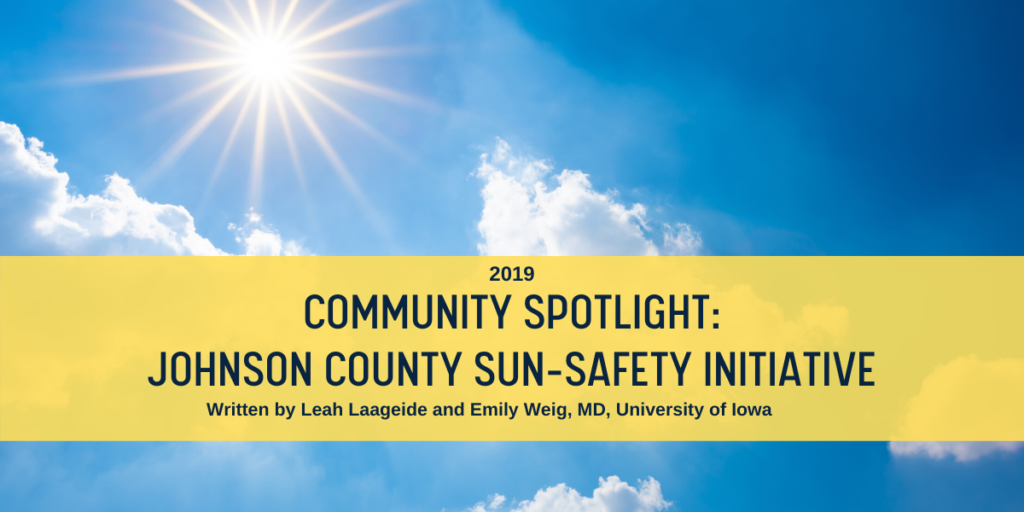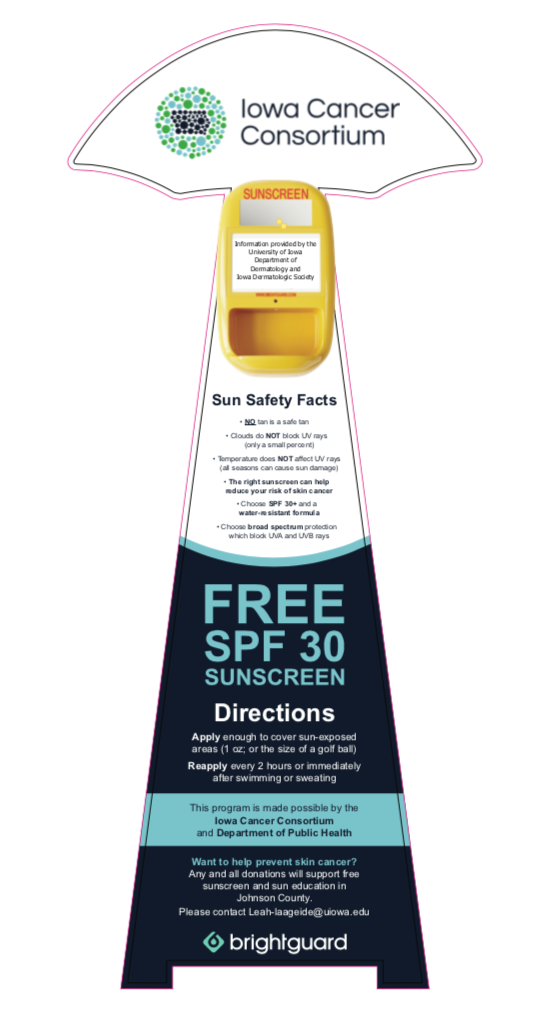Community Spotlight: Johnson County Sun-Safety Initiative

Written by: Leah Laageide (Carver College of Medicine, 2020) and Emily Weig, MD

Image: Free sunscreen dispenser
The summer season may have passed, but sun-safety is still important!
Here at the University of Iowa Hospitals and Clinics (UIHC) Department of Dermatology, we’re taking an active role to generate sun-safety awareness and promote the use of sunscreen year-round.
Supported by a grant from the Iowa Cancer Consortium, the UIHC Department of Dermatology began a sun-safety initiative in June 2019 focused on Johnson County. The project provides free sunscreen and sun-safety education using dispensers placed at local pools, parks, and events.
To evaluate the overall perception and utilization of sunscreen at these events, attendees were invited to complete a short, seven question survey. View the survey: https://www.surveymonkey.com/r/55DVFHZ.
Although most Johnson County events occur in the summer, daily sun protection is necessary regardless of the season or weather. Here are some simple tips and tricks to keep you safe all year!
Sun-Safety for All Seasons: 1-7
- Regardless of cold or overcast, UV rays can reach the skin, resulting in skin damage
- Damage eventually results in higher risk of: skin cancer, cataracts, wrinkles
- Skin cancer is the most common cancer in the U.S.
- Non-melanoma skin cancers (basal & squamous cell) affect 3 million Americans annually
- Over 190,000 cases of melanoma are estimated to arise in 2019
- UVB (“B” for burn) and UVA (“A” for tAn) rays can damage skin year-round
- Peak sun hours are between 10 am to 4 pm
- UVA can penetrate fog, clouds or glass (such as vehicle windows)
- UVB are particularly strong at high altitudes
- Snow also reflects up to ~85% of the sun’s UV light, so rays hit you twice!
- How to defend yourself against sun damage
- Daily broad-spectrum (UVA + B) SPF 30+ or protective clothing regardless of season
- Apply to all sun-exposed surfaces (including ears, around eyes, and hands)
- Apply 30-minutes before going outside, and every 2 hours thereafter
- Daily wear
- Consider a tinted sunscreen or serum (SPF 30+) if you’re a makeup-wearer
- Regardless, sunscreens do not need to be “fancy,” but rather SPF 30, broadspectrum
- “Drug-store brands,” including CeraVe, Elta MD Neutrogena, Aveeno are excellent!
- Traveling during the winter months?
- No tan is a “safe tan,” accordingly “base tans” are a myth
- In addition to sunscreen, utilize shaded areas, sunglasses, hats and/or umbrellas
For questions about the project or if you are interested in using the dispenser at a Johnson County event or location, please contact [email protected].
References:
- Deborah S. Sarnoff, MD, president of The Skin Cancer Foundation.
- Pathi, K., Pathi, K., & CityLab. (2017, May 31). New York Is Joining the Push for Free Sunscreen. Retrieved from https://www.citylab.com/life/2017/05/free-sunscreen-dispensers/528315/
- Wood, M., Raisanen, T., & Polcari, I. (2017). Observational study of free public sunscreen dispenser use at a major US outdoor event. Journal of the American Academy of Dermatology, 77(1), 164-166.
- Weig, E. Tull, R., Chung, J., Brown-Joel, ZO., Majee, R., Ferguson, NN. (2019). Assessing factors affecting sunscreen use and barriers to compliance: a cross-sectional survey-based study. Journal of Dermatologic Treatments, 19, 1-3.
- https://www.webmd.com/beauty/sun-safety-tips
- http://www.hpepublichealth.ca/sites/default/files/Winter_Sun_Safety.pdf
- https://www.prevention.com/beauty/a20478568/best-sunscreens-for-face/
- https://www.accuweather.com/en/weather-news/sunburn-still-possible-in-wint/40712
